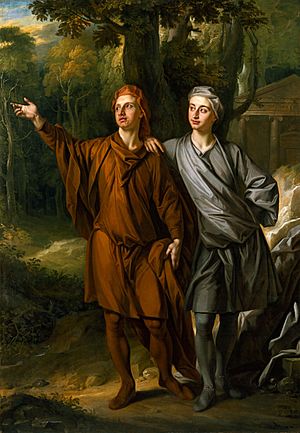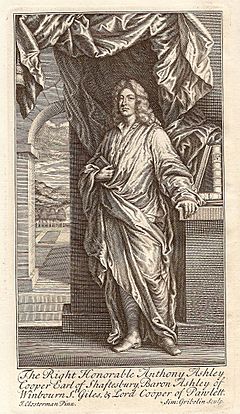Anthony Ashley-Cooper, 3rd Earl of Shaftesbury facts for kids
Quick facts for kids
The Earl of Shaftesbury
|
|
|---|---|
 |
|
| Born | 26 February 1671 London, England
|
| Died | 16 February 1713 (aged 41–42) Chiaia,Naples
|
| Era | 18th-century philosophy Early modern philosophy |
| Region | Western philosophy |
| School | Cambridge Platonism |
|
Influences
|
|
|
Influenced
|
|
Anthony Ashley Cooper, 3rd Earl of Shaftesbury (born February 26, 1671 – died February 16, 1713) was an important English thinker, writer, and politician. He was known for his ideas about how people should live and act. He was also a member of the Whig political party in England.
Contents
Who Was Anthony Ashley Cooper?
Anthony Ashley Cooper was a famous English philosopher and writer. He lived during a time called the Age of Enlightenment, when many new ideas about government, science, and human nature were being discussed. He is best known for his book Characteristicks of Men, Manners, Opinions, Times, which shared his thoughts on ethics, religion, and beauty.
His Early Life
Anthony Ashley Cooper was born in London. His father was the future Anthony Ashley Cooper, 2nd Earl of Shaftesbury. When he was very young, his grandfather, the Anthony Ashley Cooper, 1st Earl of Shaftesbury, became his guardian.
A famous philosopher named John Locke helped guide his education. Anthony was taught at home using special methods. He learned Latin and Greek by speaking them, which was unusual for the time. By age eleven, he could read both languages easily!
After his grandfather passed away in 1683, Anthony went to Winchester College. Later, he traveled around Europe with a tutor. This trip helped him learn even more about the world.
His Time in Politics
After a big change in England's government called the Glorious Revolution in 1689, Anthony returned home. He became a member of Parliament for the area of Poole in 1695. He spoke up for important laws, like one that helped people accused of serious crimes get legal help.
Even though he was a Whig, he tried not to take sides too much in politics. His health was not very good, and he often suffered from asthma. Because of this, he had to leave Parliament in 1698. He even moved to the Netherlands for a while to find a better climate.
When he returned to England, he became the Earl of Shaftesbury after his father passed away. He continued to be involved in politics, especially in the House of Lords, which is part of the British Parliament.
Later Years and Health
When Queen Anne became queen, Shaftesbury mostly retired from public life. In 1703, he moved back to the Netherlands for a while. He lived simply there.
He came back to England in 1704, but his health continued to get worse. He had symptoms of a lung illness, possibly consumption. He still cared about politics and supported England's role in the War of the Spanish Succession.
Because of his declining health, he decided to move to a warmer place. In 1711, he traveled to Italy and settled in Naples. He lived there for over a year.
His Death
Anthony Ashley Cooper, 3rd Earl of Shaftesbury, passed away in Chiaia, near Naples, on February 15, 1713. His body was brought back to England and buried at Wimborne St Giles, which was his family's home in Dorset.
Friends and Connections
Shaftesbury knew many interesting people. He was connected to John Locke's group of friends. In the Netherlands, he met other thinkers like Pierre Bayle and Jean Leclerc.
He also helped younger scholars. For example, he supported Michael Ainsworth, a young man from Dorset, to study at University College, Oxford. Shaftesbury's Letters to a Young Man at the University were written for Ainsworth.
His Important Works
Most of Shaftesbury's famous writings were finished between 1705 and 1710. He gathered many of his works into a collection called Characteristicks of Men, Manners, Opinions, Times. This book was first published in 1711.
His philosophical ideas mainly focused on:
- Ethics: How people should act and what is right and wrong.
- Religion: His beliefs about God and the universe.
- Aesthetics: Ideas about beauty and art, including the concept of the sublime, which means something that is grand, awe-inspiring, and sometimes a little scary.
What's in Characteristicks?
The Characteristicks book has three volumes.
- Volume I
- A Letter Concerning Enthusiasm: This part talks about religious toleration, meaning people should be allowed to have their own religious beliefs without being punished.
- Sensus Communis: An Essay on the Freedom of Wit and Humour: This essay explores common sense and the importance of humor.
- Soliloquy: or, Advice to an Author: This section gives advice to writers.
- Volume II
- Inquiry Concerning Virtue and Merit: In this work, Shaftesbury introduced the idea of a "moral sense." He believed that people have a natural feeling or instinct that helps them know what is good and bad.
- The Moralists, a Philosophical Rhapsody: Shaftesbury thought this was his most important work. It discusses his ideas about natural theology, which is the idea that we can learn about God by observing nature and the universe. He believed in one God who is kind and good.
- Volume III
- Miscellaneous Reflections: This volume contains other writings that had not been published before.
His Ideas on Morality
Shaftesbury had different ideas from some other thinkers of his time, like Thomas Hobbes. Hobbes believed that people are naturally selfish. Shaftesbury, however, thought that people have a natural tendency towards goodness and that being good is actually in our own best interest.
He believed that a good life comes from having balance and harmony within ourselves. If one feeling or desire becomes too strong, it can cause problems. This idea is similar to the ancient Greek philosopher Aristotle's idea of the "golden mean," which means finding a middle ground.
Shaftesbury also thought that people are social creatures. He argued that being kind and helping others (called altruism) is not against our own self-interest. In fact, he believed that when people fit in and contribute to the happiness of everyone, it makes the whole world better. This idea was very appealing to people like Thomas Jefferson, who later became a president of the United States.
Shaftesbury's idea of a "moral sense" was new. He thought that our moral feelings are mostly emotional at first, but then we learn to understand them better through education and experience. He also believed that morality is separate from religion and that we can know what is right or wrong even without specific religious rules.
Legacy
Shaftesbury left behind many writings and ideas that influenced later philosophers.
On his family estate, he built a unique building known as the Philosopher's Tower. It's still there today and can be seen from a road nearby.
A portrait of the 3rd Earl of Shaftesbury is displayed in the Shaftesbury Town Hall.
Family
In 1709, Shaftesbury married Jane Ewer. They had one child, a son named Anthony, who was born in 1711. This son later became the 4th Earl of Shaftesbury.
Shaftesbury's great-grandson was the famous Anthony Ashley Cooper, 7th Earl of Shaftesbury, who was well-known for his work helping poor people and improving society.
See Also
- Cambridge Platonists
- Moral sense theory



